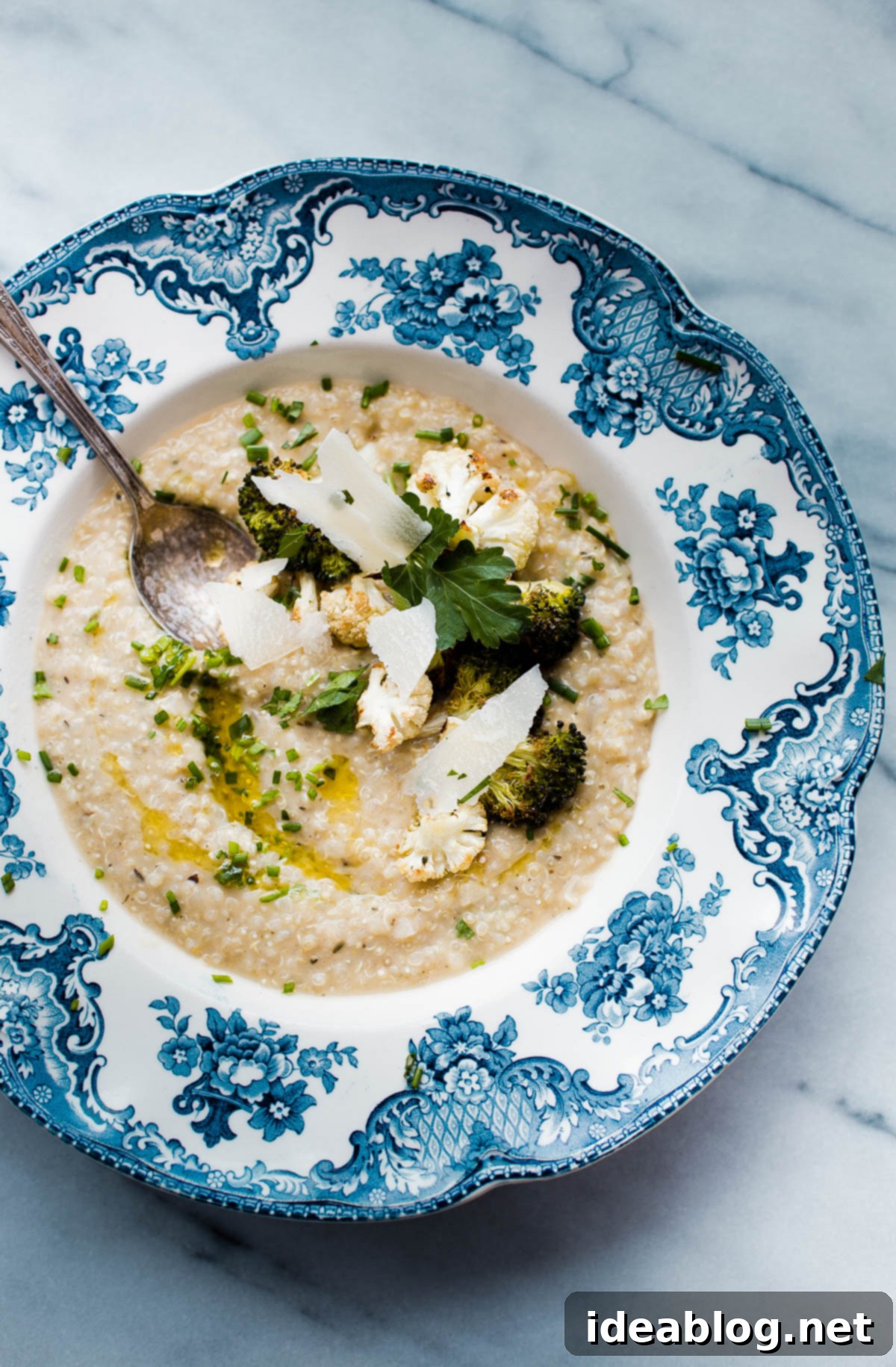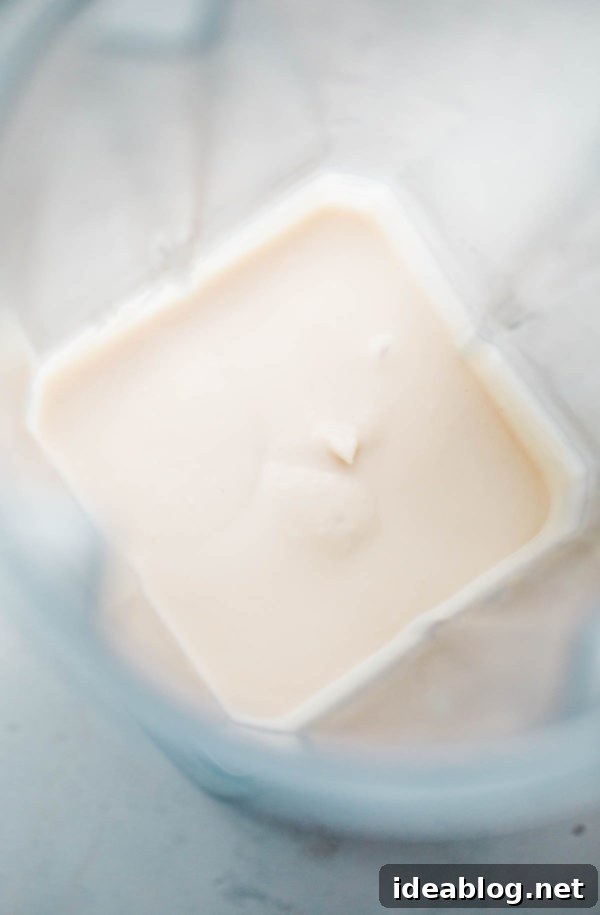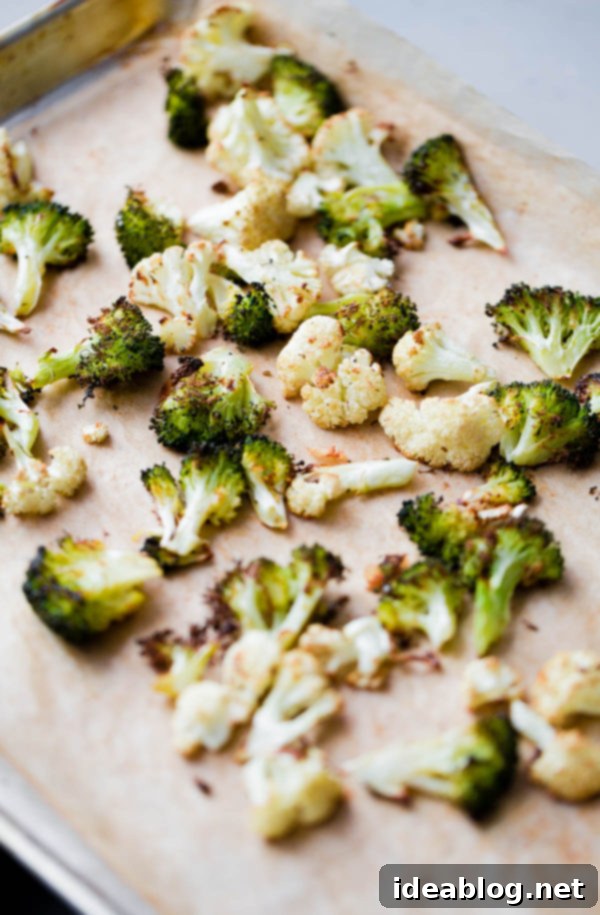The Ultimate Healthy Quinoa Risotto: Creamy, Dairy-Free & Ready in Under 45 Minutes
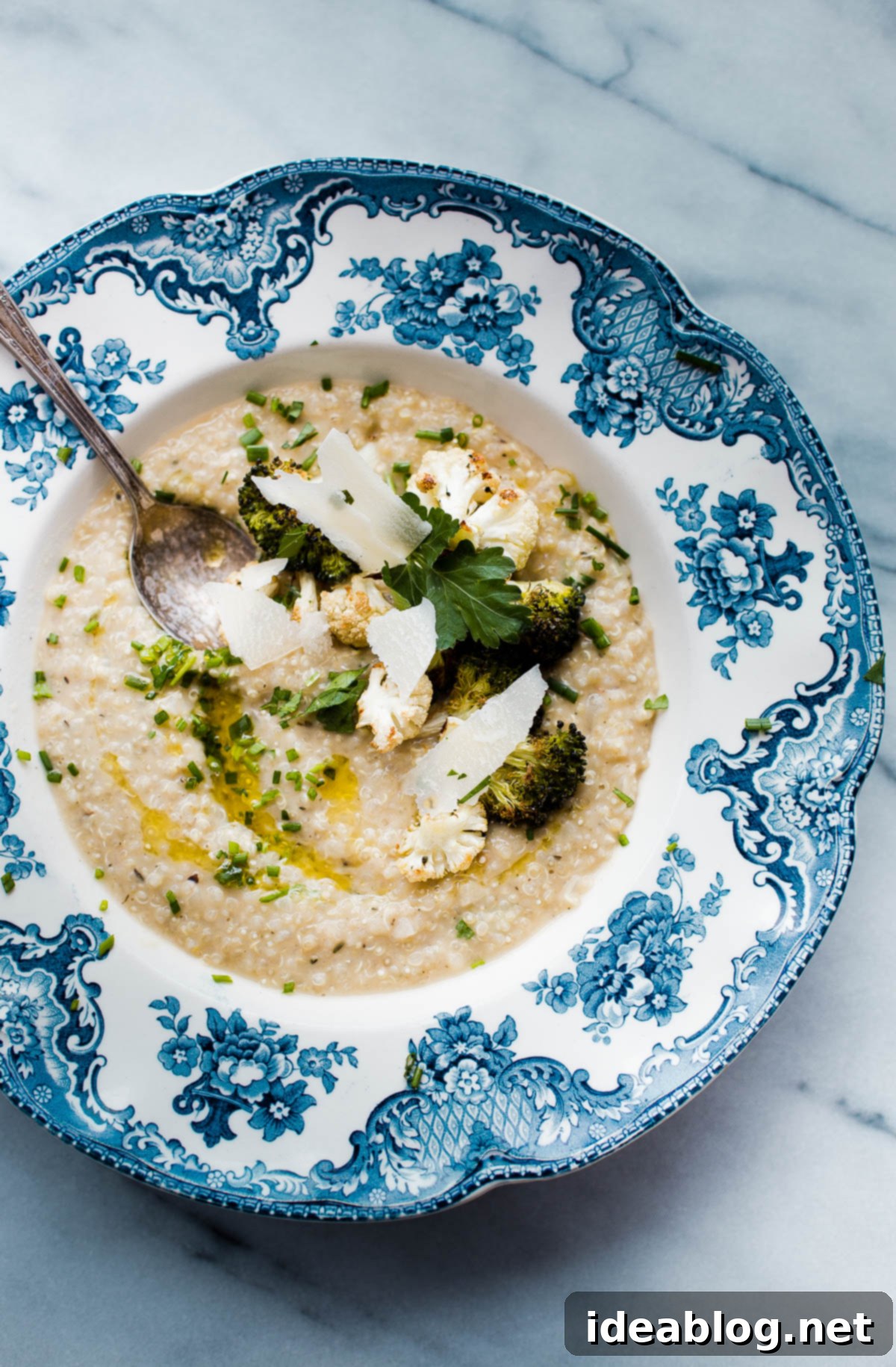
When you hear “risotto,” terms like “healthy,” “nutritious,” and “quick” aren’t typically what come to mind. Traditional risotto, while undeniably delicious, is often associated with rich dairy, a lengthy stirring process, and a somewhat indulgent profile. However, this revolutionary creamy quinoa risotto recipe challenges those notions, offering a wholesome, dairy-free, and satisfying meal that can be on your table in under 45 minutes from start to finish. It’s a game-changer for anyone seeking a healthier, faster alternative without sacrificing flavor or texture.
This ingenious concept hails from a brilliant new addition to my culinary library: The First Mess by the exceptionally talented Laura Wright. If you’re a fan of elegant, creative, and accessible plant-based cuisine, you might already be familiar with her acclaimed blog, The First Mess. I’ve been an ardent admirer of Laura’s work for many years, constantly inspired by her ability to transform simple, seasonal ingredients into extraordinary dishes. Her cookbook, launching soon, is a treasure trove of over 125 inventive plant-based recipes, each bursting with flavor and visual appeal.
While I enjoy a balanced diet that includes dairy, meat, and seafood in our weekly meal plans, my culinary curiosity is always piqued by innovative plant-based dishes. In fact, a significant portion of the recipes shared on this site lean towards vegetarian or vegan options. Laura’s philosophy deeply resonates with my own approach to cooking: prioritizing satisfaction, nourishment, and, most importantly, deliciousness in every meal. She masterfully creates food that delights the palate and feeds the soul, proving that plant-based eating can be both abundant and deeply gratifying.
As Laura eloquently states in her cookbook’s introduction, “I eat for pleasure first and tend to gravitate towards a certain overall abundance with my food – in color, textural variation, and good flavor. When I keep these things in mind with my cooking and recipes, I know that I’m creating something that transcends dietary and seasonal confines, even if it does play within them.” This ethos beautifully captures the essence of mindful, joyful eating, and it’s a principle I strive to embody in my own culinary endeavors. It’s about creating food that is inherently enjoyable and vibrant, rather than restrictive or prescriptive.
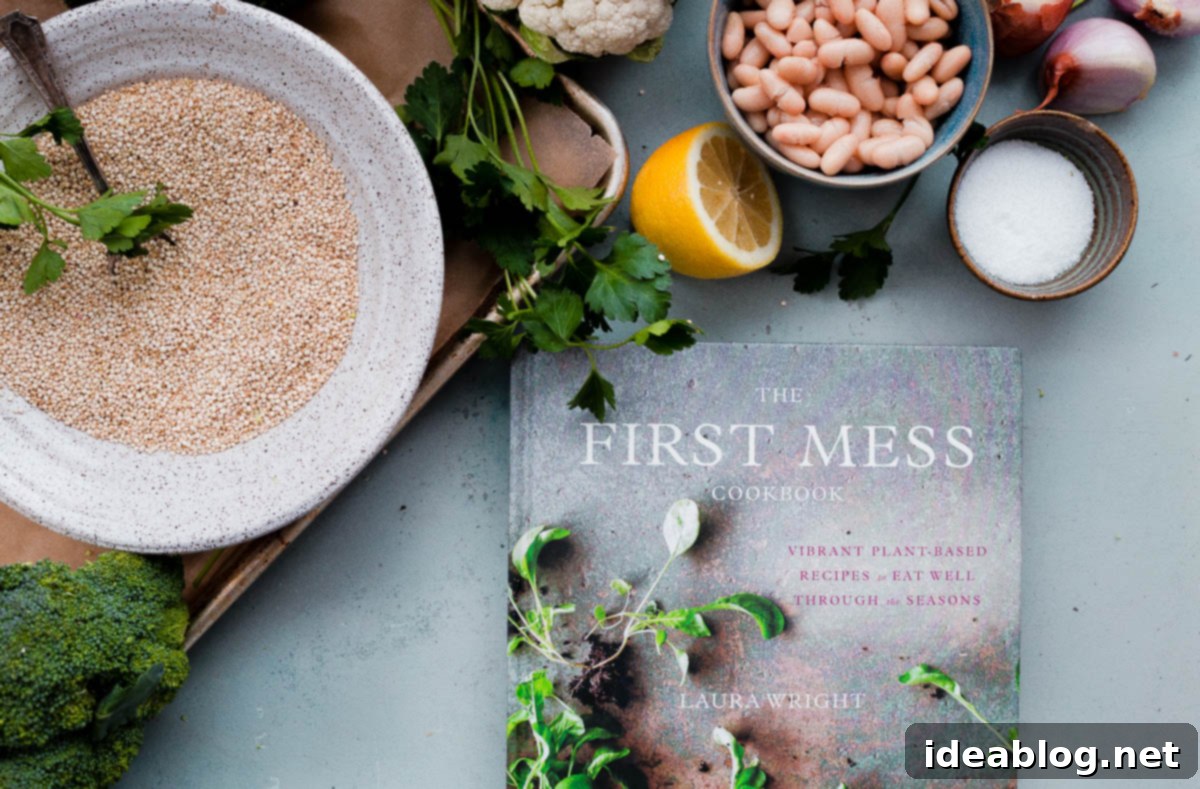
Upon eagerly flipping through the pages of The First Mess Cookbook, I found myself wanting to bookmark almost every single recipe. They possess a remarkable uniqueness and vibrancy that sets them apart. From intriguing dishes like eggplant bolognese and garlicky winter vegetable and white bean mash with mushroom miso gravy, to tempting sweets such as salted caramel date shake and raw raspberry cheesecake, the recipes are incredibly innovative. Beyond their originality, the accompanying photographs are nothing short of stunning, making each page a feast for the eyes and an inspiration for the kitchen.
Among the many enticing options, this particular quinoa risotto recipe immediately captured my attention and piqued my curiosity. Unlike traditional arborio rice, which naturally releases starch to create that characteristic creamy risotto texture, quinoa does not possess the same starchy properties. This led me to wonder: how could Laura achieve such a perfectly creamy, dairy-free risotto that looks just as inviting and luxurious as its conventional counterpart?
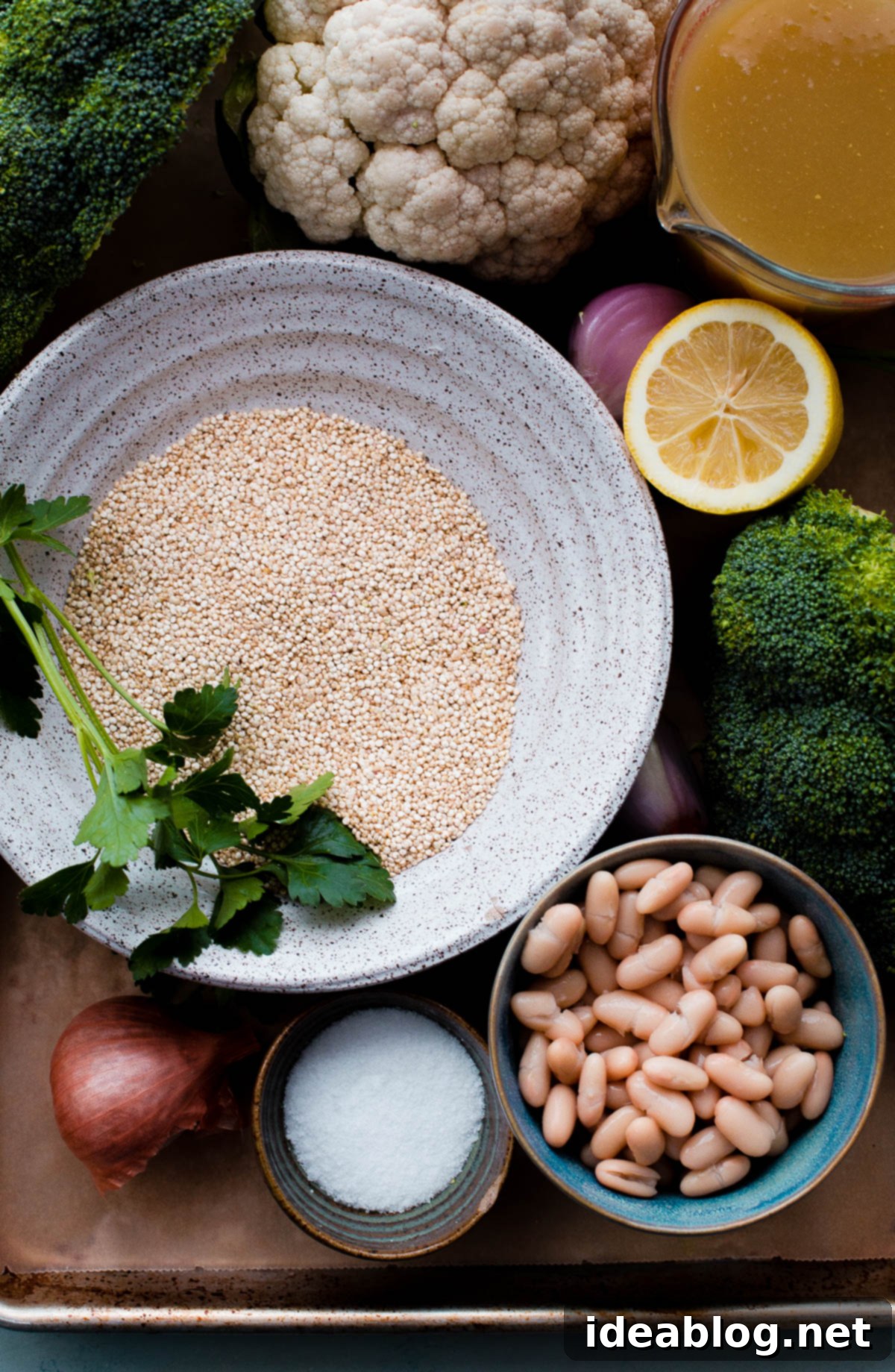
The secret to Laura’s brilliant innovation lies in a simple yet powerful ingredient: white bean puree. This humble component is the unsung hero that transforms an ordinary quinoa dish into a sensationally creamy risotto. By blending cooked cannellini or navy beans with a touch of good quality olive oil, a squeeze of fresh lemon juice, and a splash of vegetable or chicken stock, a velvety smooth puree is created. This magical puree is then stirred into the cooked quinoa, providing an unbelievably rich and creamy texture without the need for any dairy products.
While I’ve previously incorporated white bean puree into various dishes, such as enriching bolognese sauces or thickening hearty soups, the idea of using it to create a risotto-like consistency had never occurred to me until now. This is precisely what makes Laura’s cookbook so invaluable – it’s absolutely brimming with these clever, health-conscious culinary tricks and fresh perspectives that redefine what plant-based cooking can be.
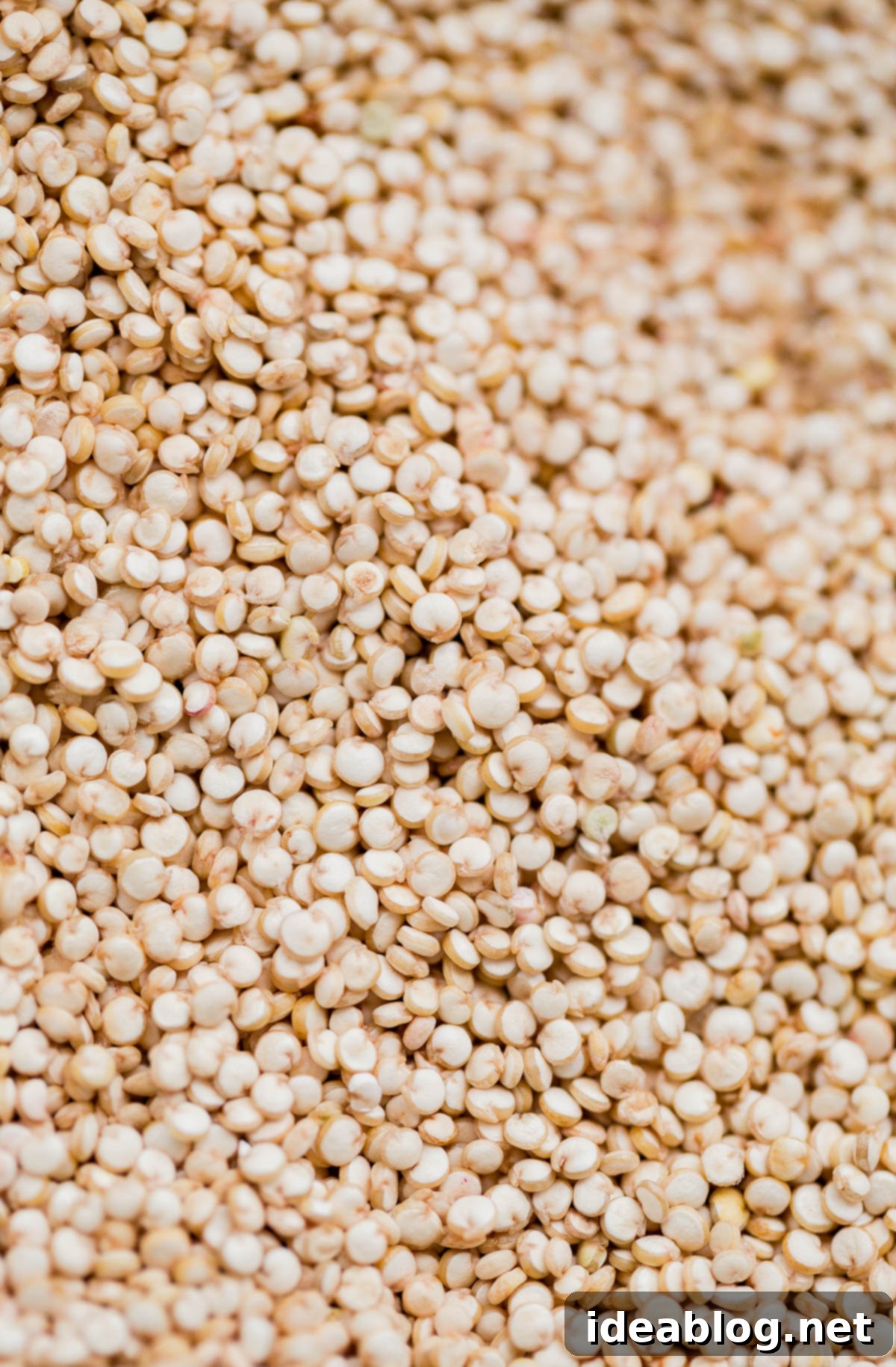
Let’s be clear and manage expectations: will this quinoa risotto replicate the exact taste and mouthfeel of a traditional arborio risotto, lovingly prepared with copious amounts of rich butter and generous shavings of Parmigiano-Reggiano cheese? Of course not! That would be an impossible feat, and I’m certain Laura herself would wholeheartedly agree. The beauty of this recipe lies not in imitation, but in its ability to create something equally, if not more, appealing in its own right.
However, the crucial question remains: is this quinoa risotto incredibly satisfying, wonderfully hearty, profoundly delicious, and truly *worthy* of a spot in your regular meal rotation? Without a shadow of a doubt, the answer is a resounding YES. It offers a unique culinary experience that stands tall on its own merits, proving that healthy eating can be both indulgent and deeply flavorful.
Beyond its exceptional taste, this quinoa risotto boasts an impressive nutritional profile. It is remarkably good for you, distinguishing itself from traditional risotto, which often serves as more of a special occasion treat. This dish is designed to be a staple, a main course that effortlessly integrates into your weekly cooking repertoire. Each generous bowl is packed with significantly more fiber and protein than traditional rice-based risotto, contributing to prolonged satiety and sustained energy. Furthermore, its preparation is remarkably fast and fuss-free, requiring just one pot and absolutely zero continuous stirring – a welcome departure from the labor-intensive nature of classic risotto. Like its traditional counterpart, this quinoa risotto is also naturally gluten-free, making it an excellent option for those with dietary restrictions or preferences.
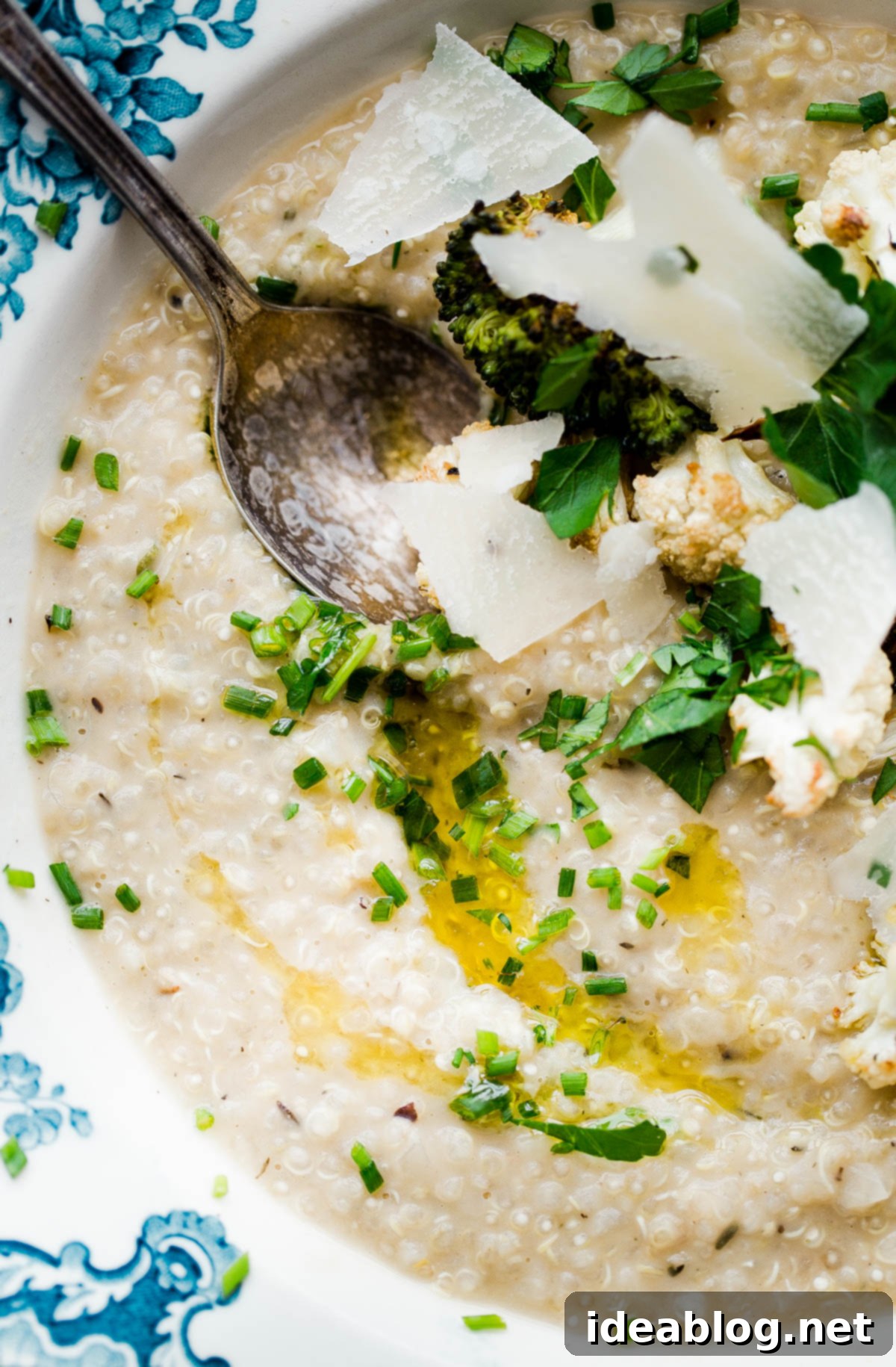
To complete this delightful dish, the creamy quinoa risotto is generously adorned with perfectly roasted brassica florets. In my preparation, I opted for a combination of tender cauliflower and crisp broccoli florets, which provide a fantastic textural contrast and an extra boost of nutrients. However, the beauty of this recipe lies in its adaptability; almost any roasted vegetable would be a superb accompaniment, allowing you to customize it based on your preferences or what’s in season.
The versatility extends even further. You can easily tailor this recipe to suit your dietary needs and taste buds. For instance, lacking vegetable stock, I chose to prepare mine with homemade chicken stock, which imparted an extra layer of savory depth. And, being a firm believer that some things are simply too good to pass up, I couldn’t resist a small sprinkle of grated Parmigiano-Reggiano cheese just before serving – a delightful touch for those who, like me, occasionally enjoy a hint of dairy. For a strictly vegan version, simply omit the cheese or use nutritional yeast for a cheesy flavor.
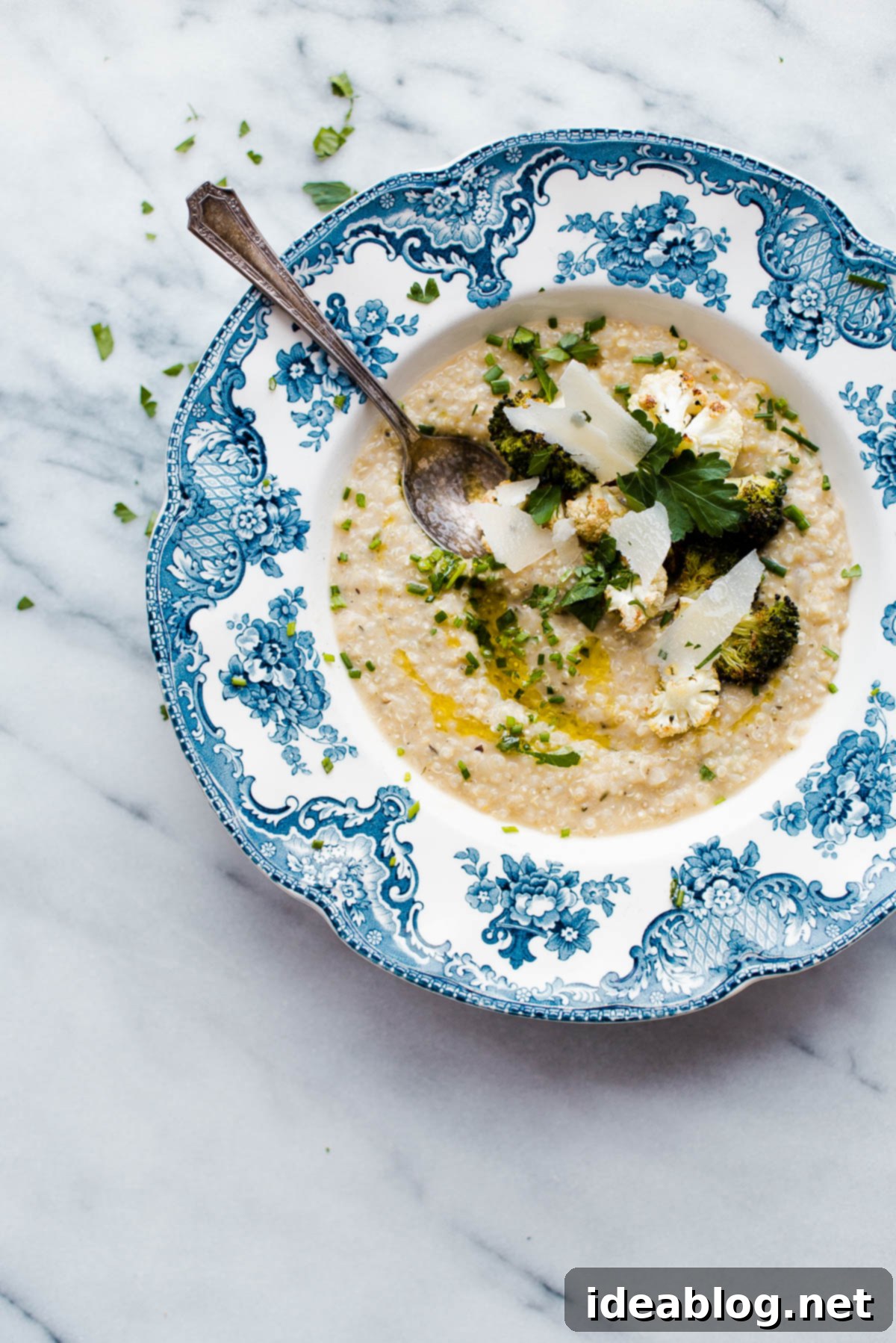
If you’re eager to discover more innovative and inspiring plant-based recipes that are both healthy and incredibly delicious, I wholeheartedly recommend exploring Laura Wright’s cookbook. It’s an indispensable resource for anyone looking to infuse their cooking with creativity, nourishment, and vibrant flavors. This Quinoa Risotto is just a glimpse into the culinary wonders it holds!
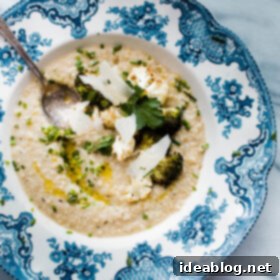
Quinoa Risotto with White Beans
Pin
Review
SaveSaved!
Ingredients
- 5 to 6 cups small cauliflower or broccoli florets, or a mixture roughly 1 to 1½ inch in size
- 2 tablespoons, plus 2 teaspoons extra virgin olive oil divided
- kosher salt to taste
- freshly ground black pepper to taste
- 1 (15 ounce) can cannellini or navy beans drained and rinsed (about 2 cups)
- 1 tablespoon (15 mL) fresh lemon juice
- pinch of nutritional yeast (or grated parmigiano-reggiano cheese, if not strictly dairy-free)
- 2⅓ cups (575 mL) vegetable or chicken stock
- 4 small shallots finely diced
- 2 teaspoons fresh thyme leaves about 4 sprigs
- 1 cup dry quinoa rinsed well
- ½ cup (120 mL) chopped fresh flat-leaf parsley divided
- extra virgin olive oil, for drizzling
- grated parmigiano-reggiano cheese for serving (optional, if not strictly dairy-free)
Instructions
-
1. Prepare for Roasting: Preheat your oven to 400°F (200°C). Line a baking sheet with parchment paper to prevent sticking and set it aside for later use.
-
2. Roast the Vegetables: Distribute the small cauliflower or broccoli florets evenly across the prepared baking sheet. Drizzle them with 1 tablespoon (15 mL) of olive oil, then season generously with kosher salt and freshly ground black pepper to taste. Toss everything together thoroughly to ensure each floret is well coated. Roast the florets in the preheated oven for approximately 20 to 25 minutes, or until their edges turn beautifully brown and crispy. Remember to flip the pieces occasionally during roasting to achieve even doneness and maximum crispness. Once done, remove from the oven and set aside.
-
3. Make the White Bean Puree: While the florets are roasting, begin preparing the creamy white bean puree. In a blender, combine the drained and rinsed cannellini or navy beans, fresh lemon juice, a pinch of nutritional yeast (or grated Parmigiano-Reggiano cheese if you’re including dairy), 2 teaspoons (10 mL) of the olive oil, and ⅓ cup (80 mL) of your chosen stock (vegetable or chicken). Blend these ingredients until you achieve a perfectly smooth and creamy consistency. Be careful not to over-blend. Once pureed, set the bean mixture aside.
-
4. Sauté Aromatics: Heat the remaining 1 tablespoon (15 mL) of olive oil in a braiser or a medium-sized soup pot over medium heat. Add the finely diced shallots and sauté them gently until they become translucent and softened, which should take about 4 minutes. Then, stir in the fresh thyme leaves and continue to cook for another minute, until the fragrant aroma fills your kitchen.
-
5. Cook the Quinoa: Add the thoroughly rinsed quinoa to the pot with the shallots and thyme. Stir well to ensure the quinoa grains are fully coated in the oil and absorb the aromatic flavors. Next, pour in the remaining 2 cups (480 mL) of stock. Bring the mixture to a boil, then reduce the heat to a gentle simmer. Cover the pot and allow the quinoa to cook until it has absorbed almost all of the liquid and is tender, typically about 13 to 15 minutes.
-
6. Achieve Creaminess: Once the quinoa is cooked, scrape the reserved white bean puree into the pot. Stir gently but thoroughly to combine the puree with the quinoa. The goal is for the quinoa to achieve a wonderfully creamy, luscious consistency without appearing dry. If, after stirring, the risotto seems a bit too thick or dry, add a small splash more of stock until the desired creaminess is reached.
-
7. Finish and Serve: Season the risotto with additional salt and pepper to taste, adjusting as needed. Stir in half of the chopped fresh flat-leaf parsley, mixing it throughout the creamy quinoa. Divide the quinoa risotto evenly among four serving bowls. Garnish each portion generously with the crispy roasted florets and the remaining fresh parsley. For an extra touch of richness and flavor, drizzle a tiny bit of extra virgin olive oil over the top, if desired. Serve this delightful and healthy quinoa risotto hot and enjoy!
Tips for Success & Variations:
- Customize Your Vegetables: Feel free to get creative with the roasted vegetables! While cauliflower and broccoli are fantastic, roasted squash, Brussels sprouts, asparagus, or even mushrooms would also work wonderfully, adding their unique flavors and textures to this versatile dish.
- Boost Flavor: For an even deeper flavor profile, consider adding a dash of smoked paprika or a pinch of red pepper flakes to the roasted vegetables or to the risotto itself during cooking.
- Add Freshness: A squeeze of fresh lemon juice just before serving can brighten up the entire dish, enhancing all the flavors.
- Nutritional Yeast vs. Cheese: Nutritional yeast provides a cheesy, umami flavor that is perfect for maintaining the dairy-free profile. If you’re not concerned with dairy, a small amount of grated Parmigiano-Reggiano adds a classic Italian touch.
- Make it a Meal: For a more substantial meal, consider adding some sautéed greens like spinach or kale during the last few minutes of quinoa cooking.
This recipe is thoughtfully adapted and reprinted with permission from The First Mess Cookbook by Laura Wright (Avery, Spring 2017). I’ve included a few of my own adaptations above to tailor it to personal preferences and highlight its versatility.
